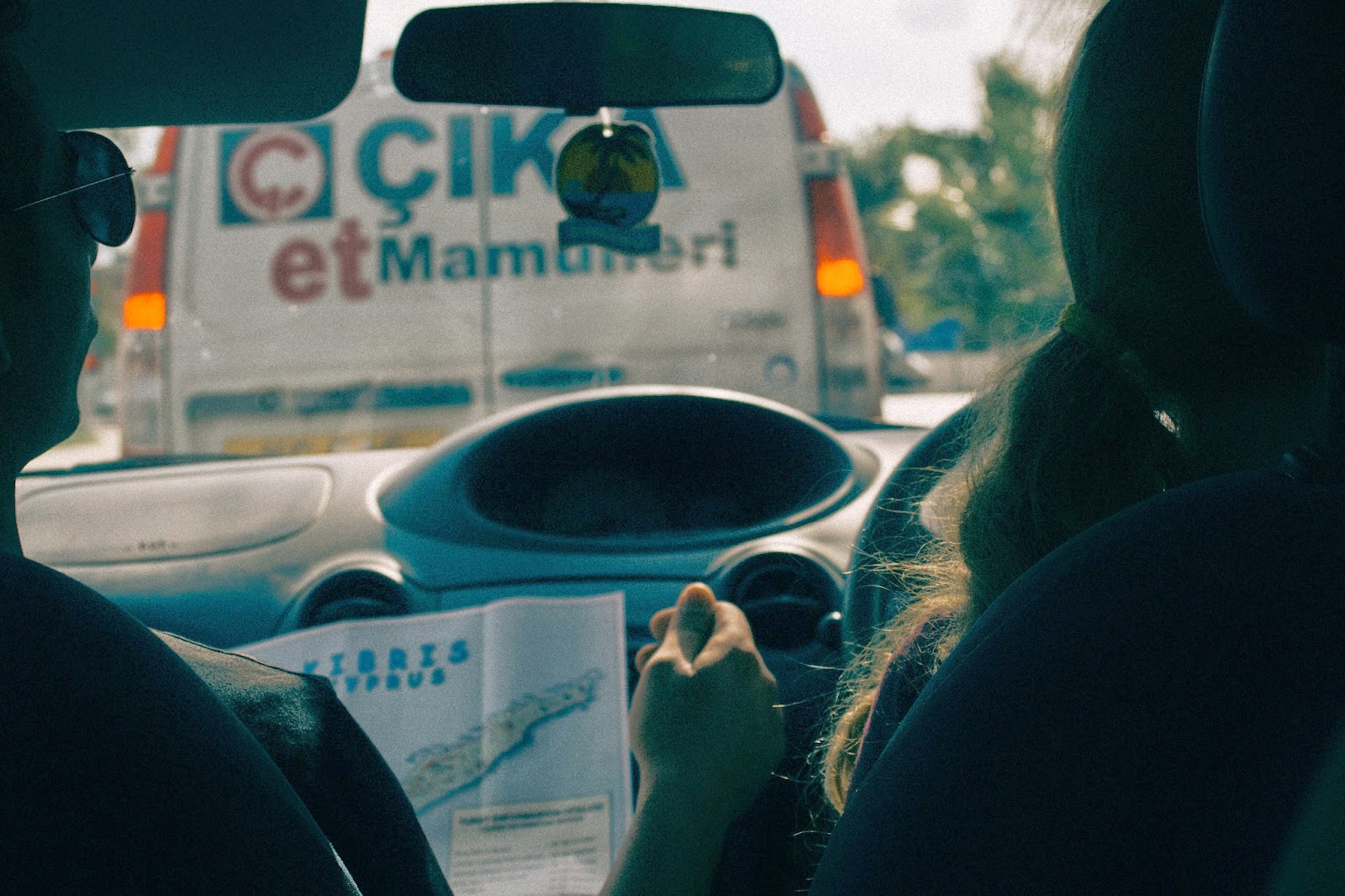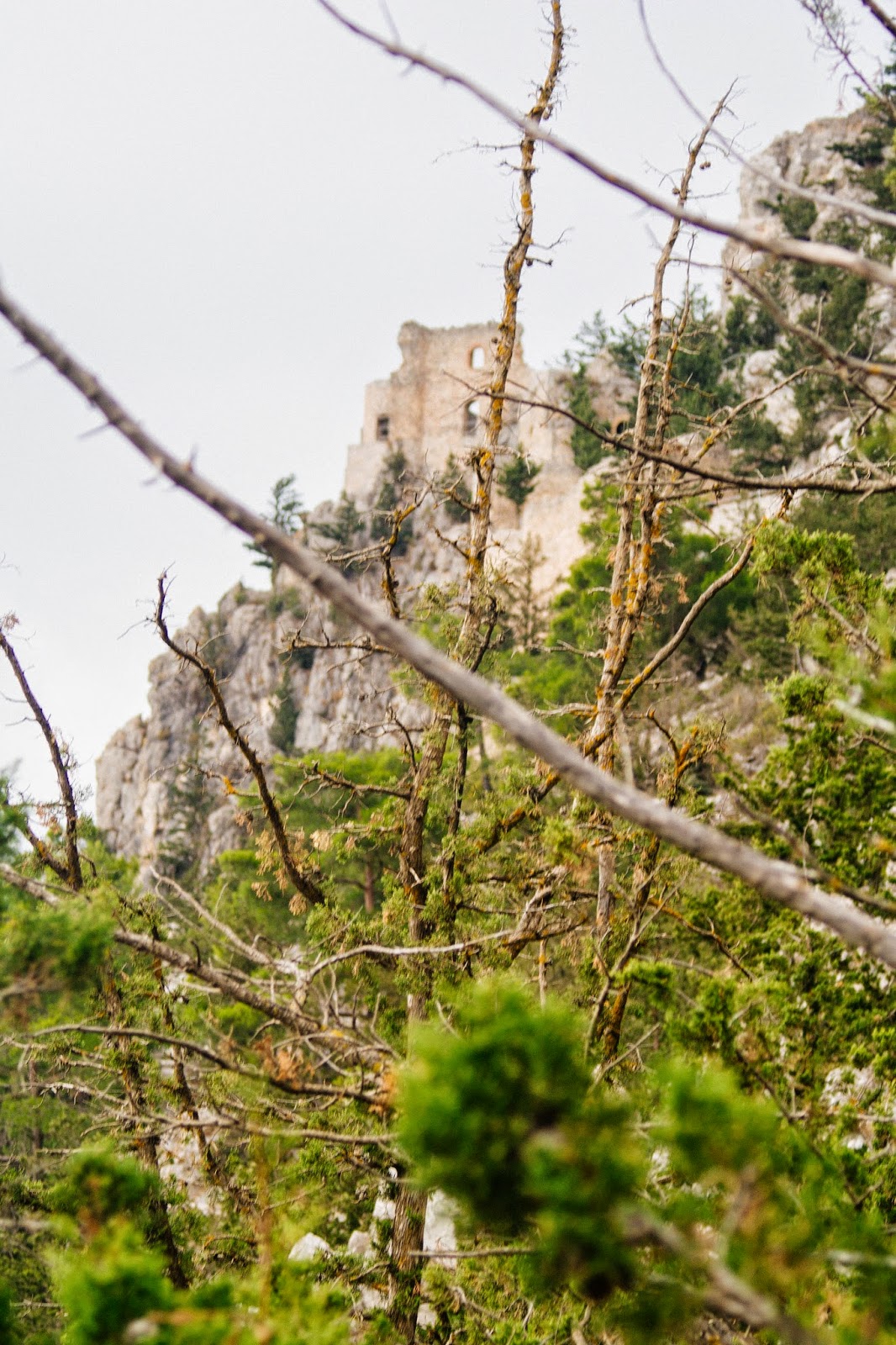Nicosia,
October 2014.
Our
trip starts early. We pack our bags with food and bathing suits and
we head down the road to cross the other
side, we are heading to Famagusta.
We are driving the road of free Cyprus now, close to the city. To our
left there is a line drawn by dry grass, the buffer zone, the dead
zone, the Green Line. Beyond this line we see the Turkish side. To
our right we see British military bases and United Nations outposts.
Towards Famagusta, close to the Sovereign Base Areas, photographs are
forbidden. We cross endless dry fields where nothing seems to exist.
Even nature looks remotely dead here.
 |
| What we see while we drive |
At the
checkpoint to enter the Turkish side we feel watched, exposed. The
sign with the flag
mocks us as we enter back to our car and slowly ride towards the
city. Our passports are checked, the car is checked. Moments later we
are crossing the streets of Famagusta. A weird statue stands in a
roundabout, new and polished, trying to say something I assume, to
prove something to the visitors. To me it sounds as breathless sounds
with no meaning. Emptiness.
 |
| The statue |
After
we park our car, we head towards the famous beach in Varosha
(Βαρώσια). My
first steps echo strangely in the atmosphere. The air is suddenly
heavier here. I notice the plastic fences cover many parts of the area we
walk. I stumble. I look at the red sign and then I stop. Not so
further beyond the artificial barricades and meters of black plastic
fences, tens of ruined buildings stand silently in front of me. The
corner of one of them is completely destroyed. It is the closest to
where I stand and it looks strange, stopped in time. I ask and
quickly learn it is bombed. It looks to me like an elevator shaft.
The elevator itself is scattered on the ground floor in pieces. Wild
nature blooms around it. This building stands here in this exact same
condition for 40 whole years. Untouched and barricaded.
We take the
small path and we enter the golden sandy beach. I think they call it
Palm Beach. Some tourists sunbathe and some others swim inside a
peaceful sea. It is a cloudy day. I look behind the beach and then I
see it; lines of buildings, deserted from the war and again those
ugly black plastic fences around them. Photos are forbidden. But who
is checking either way? Except the tourists around me, nobody seems
to be there to reassure it. The ghosts of the past drift around here
sometimes at day, they do not care about photos. They care only about
what they lost. They are grieving for a lost home, a lost relative, a
lost store, a lost life. I don't see those ghosts here today. But I
do see something.
Not even a
hundred meters by where we stand, to our right side, we discover more
barricades blocking our way through the endless beach side. The
rusty, dangerous nets scream silently “do not pass”. A guard
appears from the other side. He walks slowly out of his small
observatory, like a puma ready to attack. He comes to reassure no
pictures are taken beyond this point and I know why. What looks at
first glance as a coastline full of hotels and buildings, is actually
a ghost town next to the sea. And it extends till the eye can
see. Further in the horizon. My heart stops.
A group of
Turkish students come close and start a conversation with the guard
in Turkish. They probably protest why they can't take pictures of
this disturbing view. He slowly moves his tail and comes to a proud
position. It is time for him to explain to these youngsters all those
things he has so eagerly rehearsed in his lair. He responds with a
long explanation that sounds like preaching. We can't stop wondering
what he is saying. I am doubting whether I should ask an English
translation. Those students probably know English. But I stop and
think; do I really want to know what he is saying?
After what
seems like a thousand years, we decide not to swim there. How can we
either way? I've been told that since 2003, when the line opened,
hundreds of people who lost their properties, their families and
lives, come here often and swim in the waters and they feel good
about it. Because they can have at least that. A swim next to the old
stolen life.
 |
| The peaceful, silent waters of the beach |
We are
heading towards the car. Somehow we feel we need to witness more of
this. I know we will never come back here again during the course of
our lives, so the necessity to see more is evident. I can't stop
feeling this deep burden on my chest the whole afternoon. And the
weather is really not helping today. All those menacing clouds above
us. We ride around the barricaded city to see more of the protected
ruins. A destroyed orthodox church here, an old deserted bar there.
The sign of it still stands silent. The rest of it – probably the
owner's name – is painted with dark red color. Like the color of
blood.
 |
| The letters remained say "bar" in Greek, |
 |
| the rest is deleted with red paint. |
 |
| A very beautiful Orthodox church rots behind fences |
Next to the
fenced ghost city, I can't help but notice that life here keeps going
on. Why wouldn't it either way? It always does. Small houses, old and
new, are inhabited with people brought by the government in order to
occupy the city as proper as possible. Every morning they wake up and
they look at this.
 |
| View from a small neighborhood street |
 |
| View of a deserted house |
A few blocks
down we see an old deserted church. This is in the village area, so
we can enter. There is no door. There is actually no roof. Only some
remains stand there, yellowed by time. The pictures
on the walls seem scratched, like someone tried to erase history. It seems to be a very very old
church. So old that its historical importance and need for
restoration shout out at our bewildered faces. And absolutely nothing
can be done.
We take a
small alley and we reach the center. Some touristic shops, an old
catholic church turned into a mosque and tens of people sitting and
talking. Suddenly I feel observed. I feel the eyes of the people on
me. Strange feeling. I decide to ignore it. We take a small break and
we reach out to our car to head to the mountains. The city is too
much for us to bear.
 |
After an
hour and a half of driving, we reach the castle we were planning to
visit, the Buffavento castle. We think we are alone here when we
realize there are more crazy people like us, who drove in the middle
of nowhere to reach an old forgotten castle. We look up and we see
it. It must be quite high, but to our ignorant eyes it looks like we
can easily reach it. It takes us 40 minutes of climbing endless stone
stairs in order to finally enjoy the view. It is breathless.
The ruins of
the castle reflect a mystery. How many wars those stones have seen?
We are ecstatic and our camera's can't stop capturing moments. Tons
of fresh air enter our tired heavy lungs and it is time to descend.
On the way back with the car I notice how neglected the area is. The
excitement of the adventure didn't allow me to see this before.
Garbage is everywhere, a sign of complete neglect.
As we
ride down towards the main road, next
to Pentadaktylos Mountain range, we see the “biggest flag on theworld”. All made out of stones. White and red. Down the street two
white beautiful dogs stare at us like guards who are staring at
intruders. We drive and we drive towards the Ayios
Dhometios(Άγιος Δομέτιος)/Metehan
gate, in order to escape from all the feelings, all the burden, all
the pain this land carries. The words of my beloved friend echo in my
head again and again: “Who cries for these buildings, these
streets, these trees? Who weeps for all these?”.
 |
| Going back home... |
Below: Glimpses of Famagusta city and how it looks today.
Famagusta,
Cyprus, October 2014
Vicky Griva Photography ©
Οι φωτογραφίες είναι πνευματική ιδιοκτησία της φωτογράφου. Κάθε χρήση τους χωρίς την ειδοποίηση της δημιουργού απαγορεύεται και διώκεται ποινικά.








































No comments:
Post a Comment